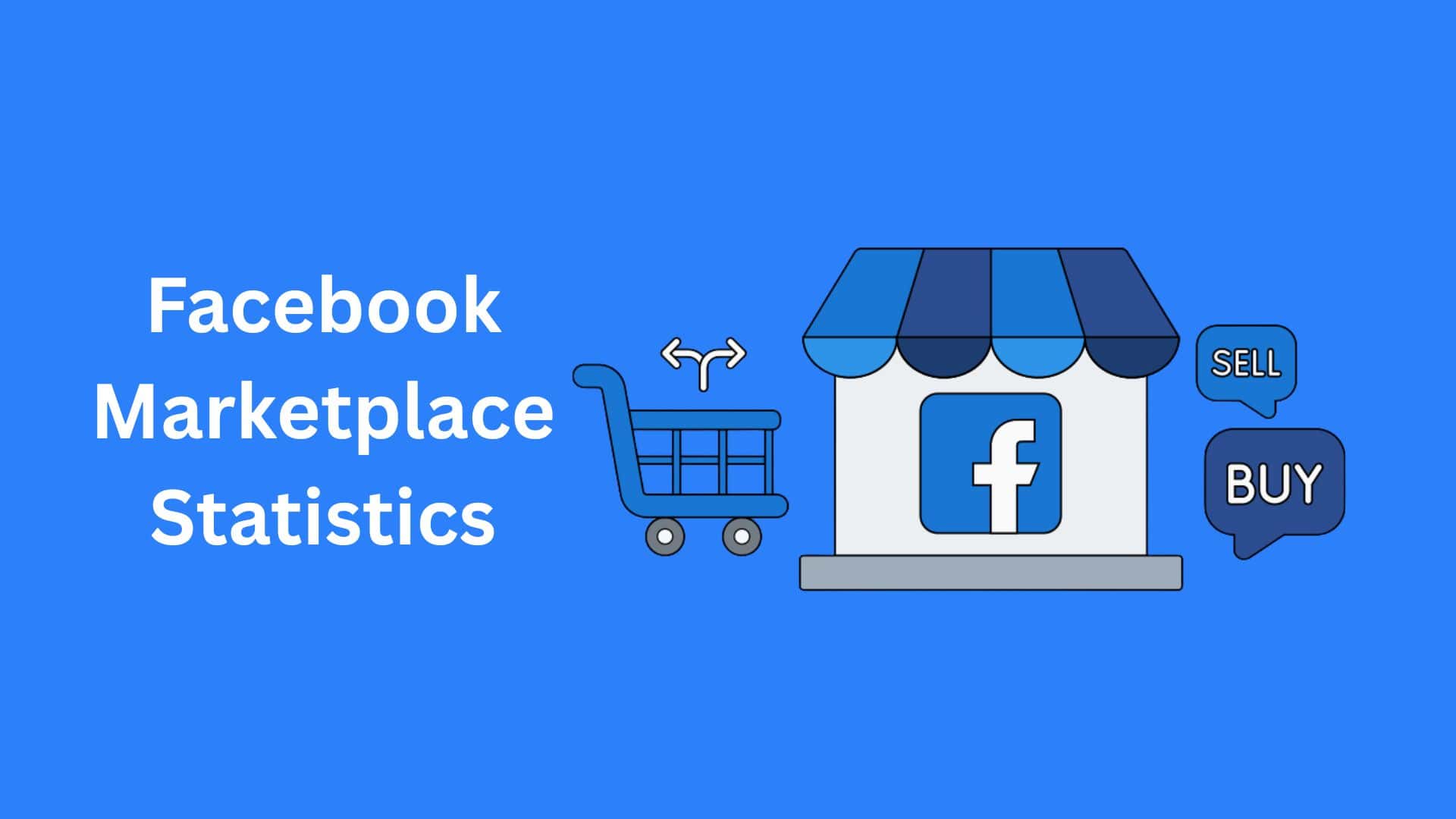Freelance Statistics By Market Size And Facts (2025)

Updated · Oct 03, 2025


WHAT WE HAVE ON THIS PAGE
- Introduction
- Editor’s Choice
- The Origin and Global Scale of the Freelance Movement
- The Freelance Workforce
- Freelance Earnings and Compensation
- Freelance Market Size
- Impact on Freelance Skills and Demand
- Platform Dominance and Operational Freelance Data
- Projections, Coworking, and the Post-Pandemic Legacy
- Conclusion
Introduction
Freelance Statistics: The world of work is undergoing a profound, irreversible change, and at its very core is the unstoppable rise of the Freelance professional. What began as a side hustle for a select few is now a foundational pillar of the global economy, driven by demands for flexible, specialized talent and the tech platforms that connect them. As corporations undergo economic volatility, employees prioritize independence.
This article will discuss Freelance adoption, moving beyond generic information to focus exclusively on the exact data and numbers: market projections, demographic shifts, earnings data by skill and region, and the impact of next-generation tech like Artificial Intelligence. Let’s get started.
Editor’s Choice
- The global independent worker population has reached a monumental 57 billion people, meaning nearly half of the world’s workforce is engaged in some form of self-employment or contract work.
- The overall US Freelance economy is valued at more than $1.3 trillion annually, a financial contribution that is substantial enough to rival the Gross Domestic Product (GDP) of major nations.
- The number of US freelancers is projected to hit 1 million by the year 2028, demonstrating an aggressive, sustained growth that will add over 10 million new professionals in three years.
- The specific market for Freelance platforms is expected to grow by 1% annually, with the total value projected to reach $16.89 billion by 2029.
- The US Freelance workforce is now a slight majority female, with women making up 3% of independent contractors, though a pay gap persists.
- A high percentage of 70% of all independent professionals report that they are working as a Freelance professional by choice, indicating a clear preference for autonomy over traditional employment.
- An overwhelming 69% of freelancers in the US hold at least a Bachelor’s degree, which validates the highly educated and specialized nature of this independent workforce.
- Gen Z and Millennials are driving the shift, with 52% and 44% participation rates, respectively, showing a preference for project-based careers over a single employer.
- The global average hourly rate for high-skill independent professionals stands at approximately $101.50, reflecting a significant premium for specialized technical and strategic expertise.
- The most lucrative industry for independent contractors is Banking and Finance, where the average hourly rate is the highest, at $110.88/hr for specialized consulting work.
- Top-tier Freelance Programmers in the US achieve a median annual income of $120,000, with the top 10% often surpassing $200,000 for complex technical projects.
- A robust 65% of independent professionals confirm that their Freelance income is now either equal to or higher than what they previously earned in a conventional, full-time job.
- Demand for Generative AI skills on major platforms has seen an exponential 600% surge in job posts within a single year, making it the fastest-growing skill category.
- Strategy Professionals in high-value markets command the highest average day rate at £520/day, underscoring the value placed on high-level strategic guidance and problem-solving.
- The rise of AI is disproportionately affecting new entrants, with a 13% relative decline in employment for Early-Career (22 to 25) workers in AI-exposed roles.
- Specialists in Cybersecurity can typically command a rate that is 30 to 50% above the general Freelance market baseline due to the high-risk, high-reward nature of their expertise.
- Upwork’s Gross Services Volume (GSV) has shown strong growth, exceeding $1.027 billion in a single quarter, reflecting the massive flow of transactions through its platform.
- The average contract length for highly skilled work is approximately 23 days, indicating a market preference for short, rapid, and highly specific project engagements.
- A significant 30% of experienced independent workers are paid on a flexible hourly basis, a hybrid approach that balances project security with ongoing consultation needs.
- The massive scale of corporate reliance on contractors is highlighted by Google’s contingent workforce, which previously totaled 120,000, exceeding its permanent staff count of 102,000.
- The pandemic spurred 2 million new entrants into the US Freelance workforce, permanently accelerating the transition toward independent professional careers.
- Corporate adoption of permanent remote work is projected to more than double pre-pandemic levels, stabilizing at approximately4% of workforces, which heavily supports the Freelance model.
- India’s gig economy is forecast to grow to 350 million gig workers by 2025, establishing it as a dominant global source of independent talent.
- Despite the growth of flexible offices, a strong 82% of independent contractors report that they work exclusively from home, underscoring the primary value of location independence.
The Origin and Global Scale of the Freelance Movement
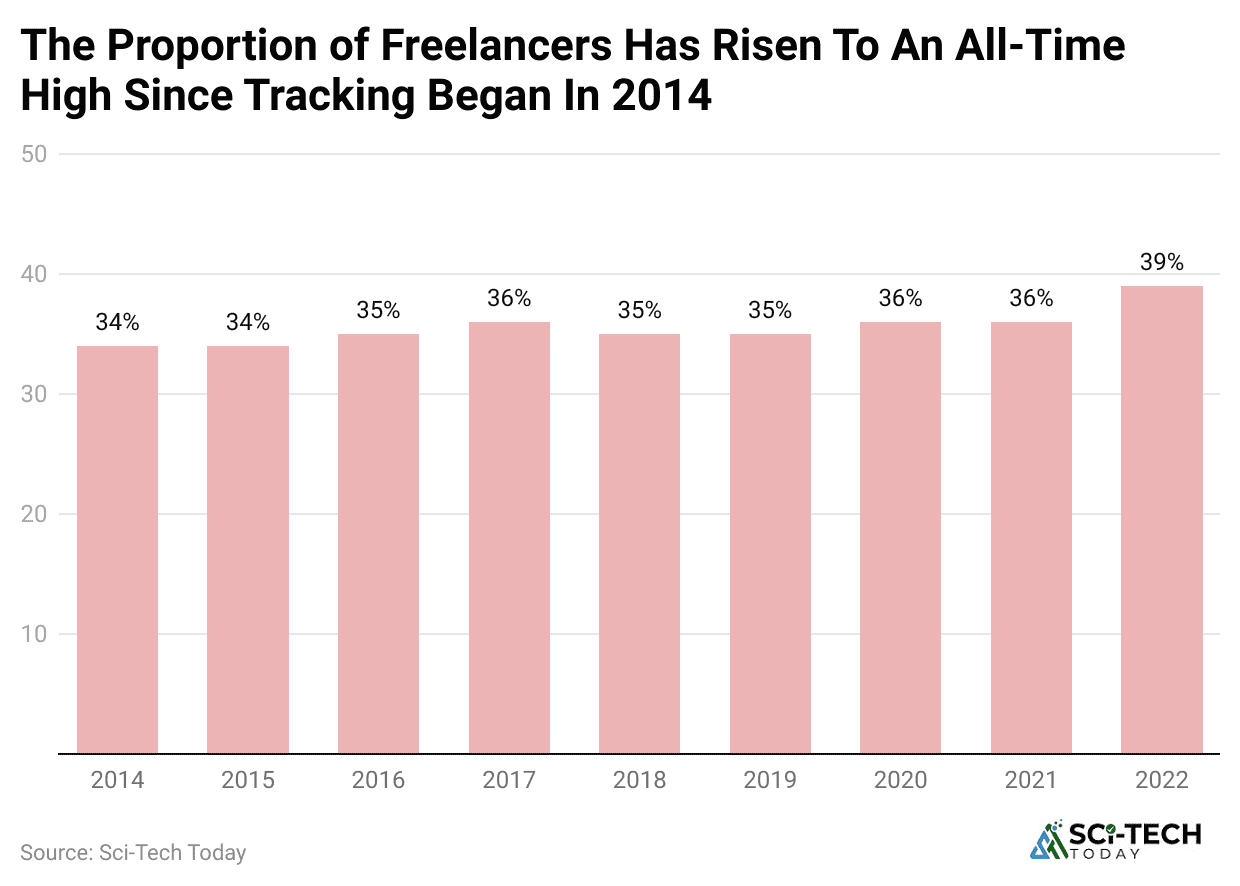
- As of 2025, there are an estimated 1.57 billion individuals worldwide who are self-employed or engaged in independent work, representing approximately 46.7% of the planet’s total global workforce.
- The entire global Freelance market is conservatively projected to reach a colossal value of over $1.5 trillion and is forecast to continue expanding at a robust Compound Annual Growth Rate (CAGR) of 15% through 2026.
- The United States alone commands the largest single national Freelance market, housing approximately 80 million independent professionals as of 2025, which translates to almost 40% of the entire American workforce.
- This massive segment contributes a substantial figure, with the total economic value generated by US freelancers estimated to be well over $1.3 trillion annually, a figure that rivals the GDP of many nations.
- The specific market for Freelance platforms, the digital marketplaces that connect talent with clients, is expected to surge dramatically, with projections indicating it will hit $8.39 billion by the end of 2025.
- Looking further ahead, this platform-centric market is anticipated to nearly double, reaching an impressive $16.89 billion by 2029, with an accelerated annual growth rate of 19.1%.
- While developed nations dominate total earnings, emerging economies are seeing the highest percentage growth in their Freelance workforces, fundamentally reshaping the global talent map.
- For instance, South Africa has seen a remarkable 126% increase in its number of freelancers YoY, significantly outstripping the substantial 68% growth observed in the United States and the 64% rise in Canada.
- The independent workforce in the United States is not slowing down; current data projects that the number of individuals engaging in Freelance work will swell to 79.6 million by 2025.
- This is confidently expected to breach the 90.1 million mark by the year 2028, implying that over the next three years, the Freelance sector will add more than 10 million new professionals to its ranks.
| Global Freelancer Population | 1.57 Billion |
| US Freelancer Population (2025) |
80 Million |
|
US Freelance Economy Value |
$1.3 Trillion |
| Freelance Platform Market Size (2025) |
$8.39 Billion |
|
Highest Annual Growth in Freelancers |
South Africa (126% increase) |
| US Freelancer Projection (2028) |
90.1 Million |
The Freelance Workforce
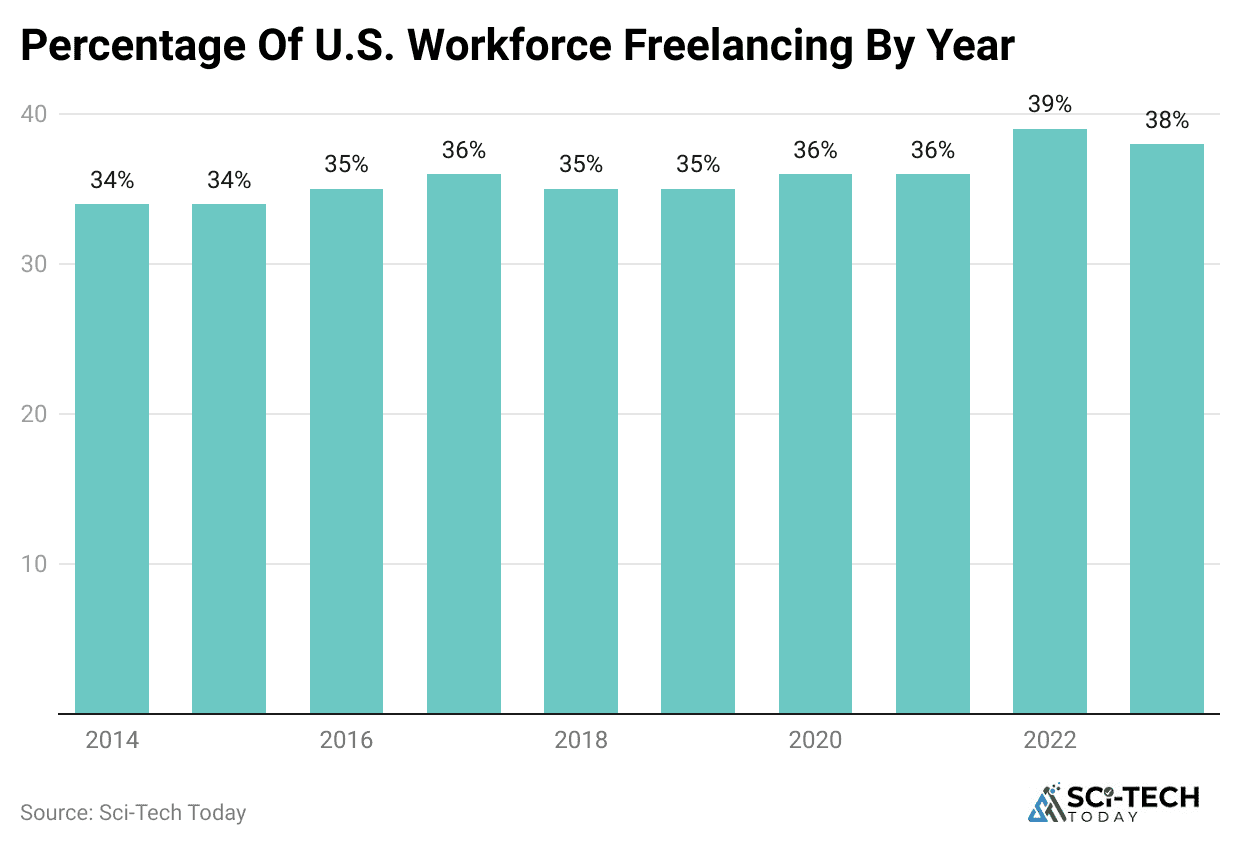
- The overall gender split among US freelancers has tipped slightly, with approximately 52.3% of all independent workers identifying as female, compared to 47.7% who are male.
- Younger generations are significantly more inclined to embrace the Freelance model than their older counterparts, with an impressive 52% of Gen Z (ages 18 to 25) and 44% of Millennials having engaged in some form of independent work.
- The notion of Freelance work being low-skilled is dismantled by education statistics, which show that nearly half (50%) of all independent professionals in the US hold a post-graduate degree, a significantly higher percentage than the general workforce.
- Specifically, 69% of freelancers report having a Bachelor’s degree, validating the high value placed on their specialized skills and expertise.
- Despite the female majority in the US Freelance sector, a noticeable gender pay disparity exists, with female freelancers earning an average of only 70 cents for every dollar earned by their male counterparts on an hourly basis.
- This gap is further quantified globally, where the average hourly rate for women is approximately $37, lagging behind the male average of $52.
- The average professional transitioning to a Freelance career is not a novice; the typical independent worker has already spent an average of 12 years gaining specialized experience in a traditional employment setting before leaping.
- The average age of a US freelancer is now trending slightly upward, settling at about 38 years old, reflecting a workforce that brings significant veteran expertise to contract roles.
- The vast majority of the Freelance workforce, approximately 70% of independent contractors in recent surveys, report that they work independently by choice rather than out of necessity due to an inability to find traditional employment.
| Gender Ratio (Female) | 52.3% |
| Gen Z / Millennial Participation | 52% / 44% |
| Freelancers with a Bachelor’s Degree | 69% |
| Freelancer Average Age | 38 years |
| Voluntary Freelancers | 70% |
| Female Freelancer Hourly Earnings (vs. Male $1) | $0.70 |
Freelance Earnings and Compensation
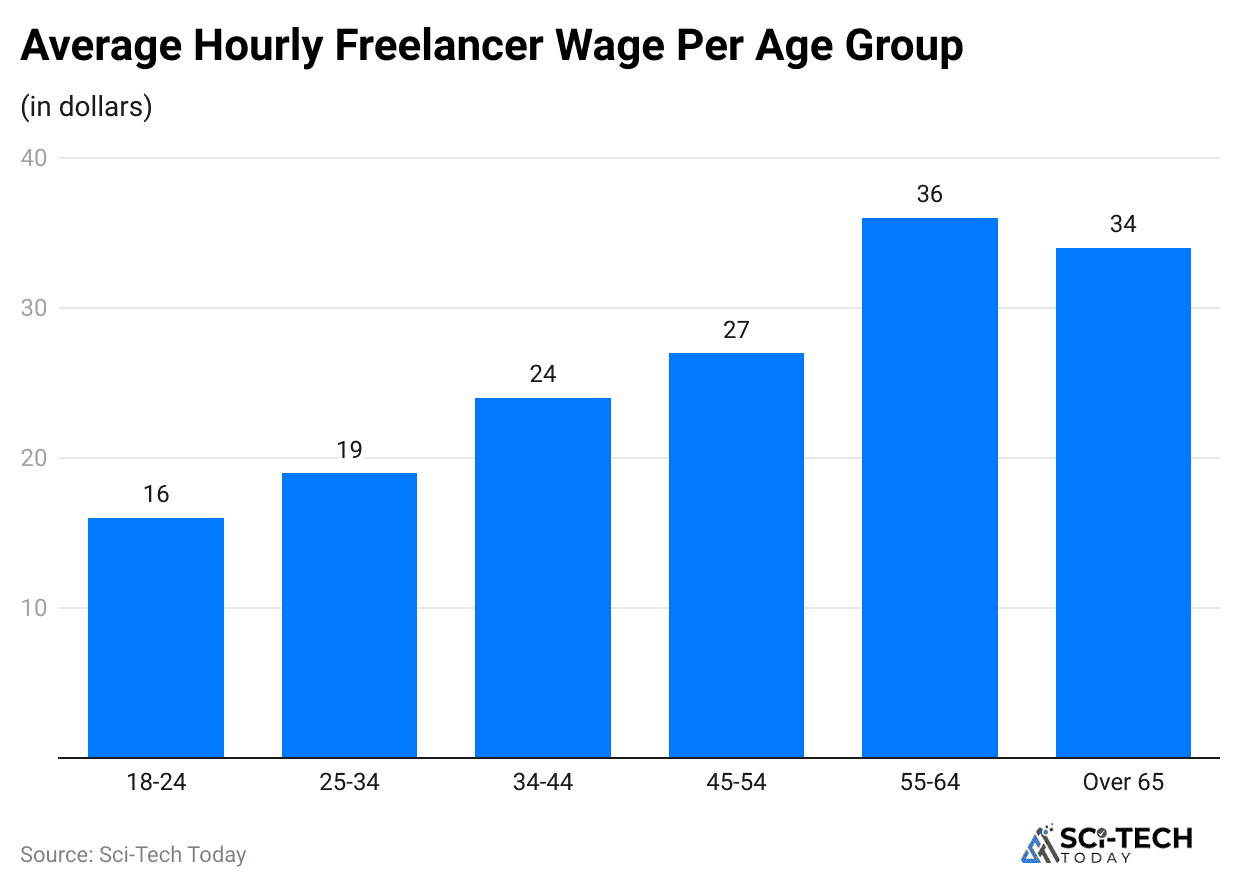
- The worldwide average hourly rate commanded by independent professionals stands at approximately $101.50, according to one major global study, reflecting a premium for highly sought-after, technical Freelance expertise.
- However, this global average is heavily skewed by developed markets, as the average for US freelancers sits closer to $47.71 per hour.
- The most financially lucrative industry for independent contractors is the Banking and Finance sector, where freelancers can expect to charge an average of $110.88 per hour for specialized consulting and project work.
- This is closely followed by the Healthcare/Pharmaceutical sector at $109.83/hr and the Energy sector at $108.82/hr, indicating a high demand for regulated industry expertise.
- An experienced Freelance Software Developer or Programmer in the United States commands an average hourly rate of $60 to $70, leading to an impressive median annual income of approximately $120,000.
- The top 10% of these specialized technical freelancers can significantly exceed this, with annual earnings that can soar well past $200,000 for complex projects like AI/ML or Cybersecurity engineering.
- Specialization is the key to premium pricing, with AI/Machine Learning Engineers commanding the highest rates, typically billing between $35 and $160 per hour globally.
- This specialization premium results in these roles charging 40 to 60% more than the general Freelance baseline, followed closely by Cybersecurity experts who charge a premium of 30 to 50%.
- The financial benefits of working independently are substantial, with a large majority, approximately 65% of independent professionals, reporting that their Freelance income is equal to or higher than what they previously earned in a conventional, full-time job.
- Freelancer hourly rates exhibit extreme geographic variation due to local cost of living and global outsourcing dynamics, with a huge rate difference for US/EU clients.
- For instance, while a developer in the United States might bill $95 to $110 per hour, a highly skilled developer in India typically charges between $30 and $50 per hour, demonstrating a significant cost advantage for businesses seeking global talent.
| Global Average Freelancer Hourly Rate | $101.50 |
| Highest Paid Industry Average | Banking and Finance ($110.88/hr) |
| US Freelance Programmer Annual Income | $120,000 |
| AI/ML Engineer Hourly Rate Range | $35 to $160/hr |
| Freelancers Earning More Than Traditional Jobs | 65% |
| Top 10% Freelancer Daily Rate (UK Market) | £708/day |
Freelance Market Size
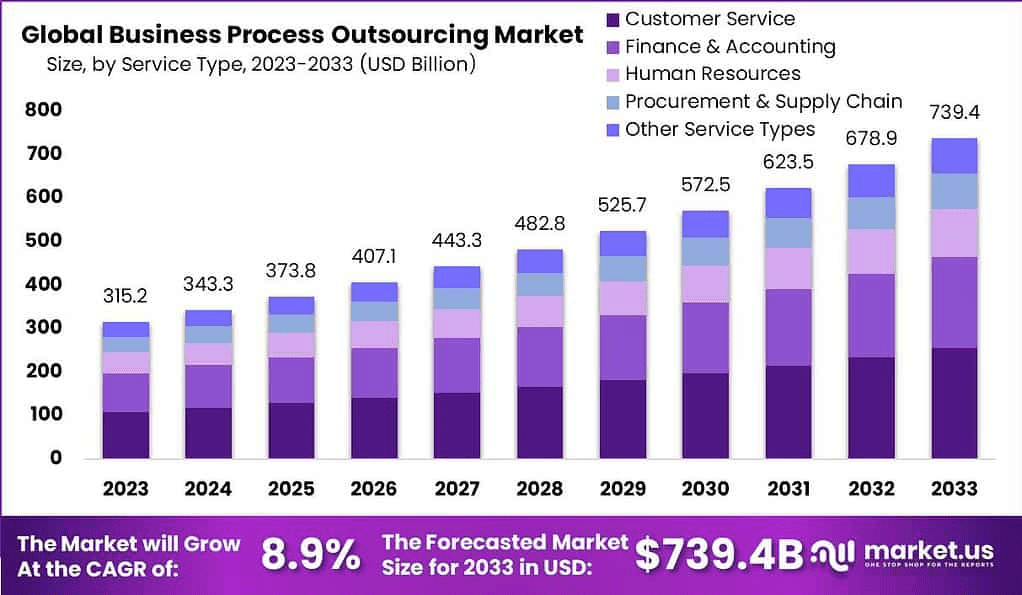
According to Market.us, the Business Process Outsourcing (BPO) sector is undergoing a profound transformation, moving beyond a simple cost-reduction model to become a critical engine for strategic growth and technical specialization for global enterprises. The latest data quantifies this acceleration, highlighting where the market is expanding, which services hold the most value, and where regional investment is concentrated.
- The global BPO market is on an aggressive growth trajectory, with its valuation expected to more than double from an estimated $343.3 billion in 2024.
- The market is forecast to reach a staggering $739.4 billion by 2033, maintaining a robust Compound Annual Growth Rate (CAGR) of 8.9%.
- This expansion is fundamentally driven by corporations strategically shedding non-core functions, such as customer service, HR, accounting, and IT management.
- The Service Type segment remains the foundation of the market, dominating the BPO landscape by capturing 34.5% of the total share in 2023.
- Large Enterprises are the undisputed financial backbone of the BPO sector, having commanded an overwhelming 67.0% market share throughout 2023.
- The IT & Telecommunications sector emerged as the leading industry vertical in 2023, securing a significant 36.1% share of the total BPO market.
- North America remains the financial powerhouse of the BPO market, capturing 38.4% of the global share in 2023 and generating a massive USD 121 billion in revenue.
Impact on Freelance Skills and Demand
- The demand for freelancers with specific, hands-on experience in Generative AI tech saw a staggering 600% increase in the number of weekly job posts on major platforms during 2023.
- The specialized services segment, encompassing computer programming, IT, marketing, and business consulting, now accounts for approximately 53% of the entire US Freelance workforce, an increase from 50% just a year prior.
- Within the creative and tech disciplines, specialized skills like UX Design and Machine Learning are commanding the highest rates, significantly boosting a freelancer’s market value.
- Data shows that Strategy professionals generally command the highest rates overall, with an average daily rate of £520 in the UK market, followed closely by Market Research professionals at £491.
- Professions whose core tasks are highly susceptible to automation, such as translation, are already experiencing a measurable impact, with the employment of translators and interpreters in the US decreasing by nearly 3% over the last five years.
- Early-career workers (ages 22 to 25) in the most AI-exposed occupations, such as software development and customer service, have experienced a 13% relative decline in employment since the widespread adoption of Generative AI tools. In stark contrast, employment for more experienced workers in the same exposed fields has remained stable or continued to grow, suggesting a premium being placed on human judgment and complex problem-solving.
| Growth in Generative AI Job Posts | 600% |
| Percentage of Workforce in Specialized Services | 53% |
| Highest Day Rate for a Skill (UK) | Strategy Professionals (£520) |
| Employment Decline in Translation (5 years) | 3% |
| Highest Risk Group to AI Impact | Early-Career (22 to 25) workers |
| Premium for Cybersecurity Specialists | 30-50% above baseline |
Platform Dominance and Operational Freelance Data
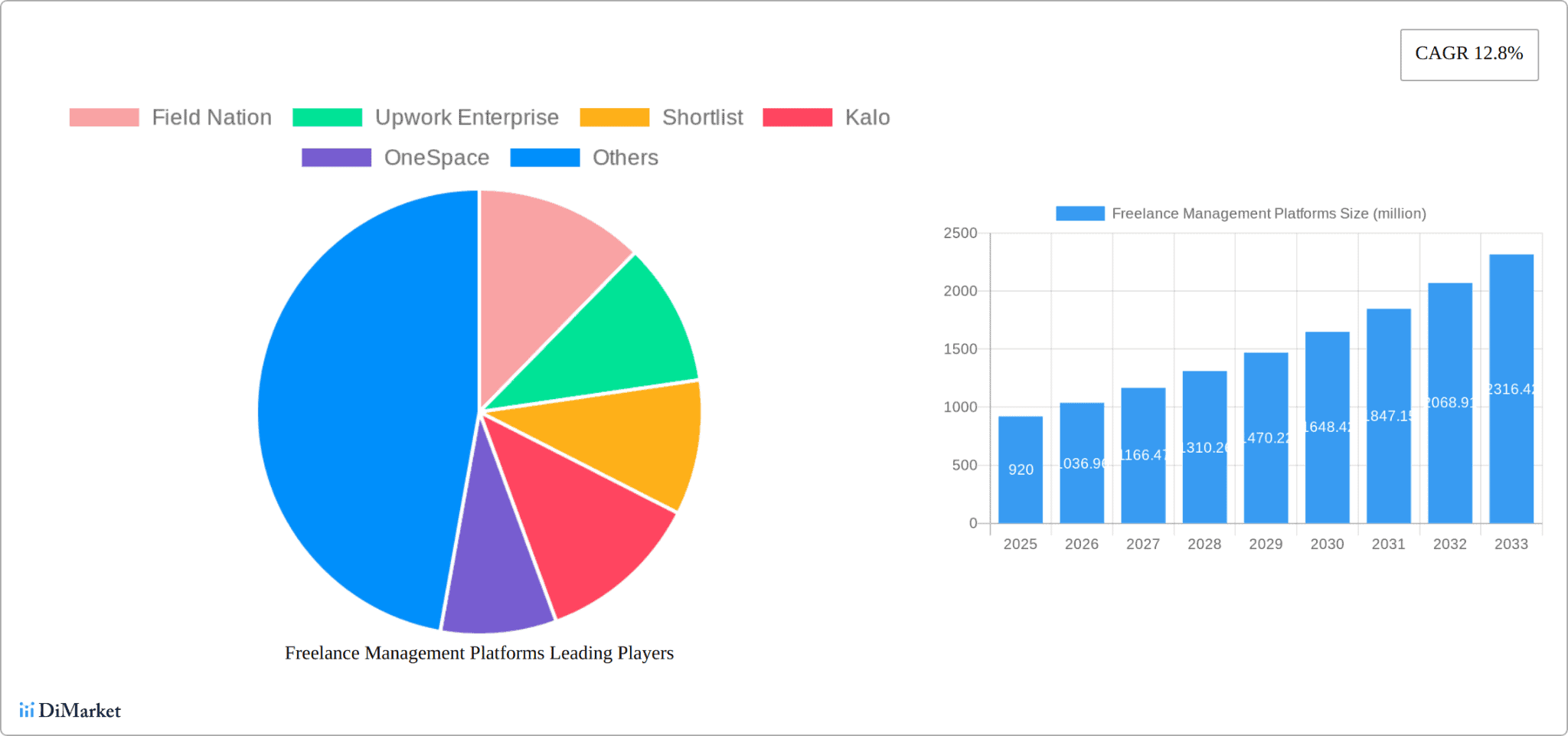
- Upwork, one of the world’s largest Freelance marketplaces, reported an annual revenue of $618 million in 2022, representing an approximately 23% increase over the previous year.
- Furthermore, the platform’s Gross Services Volume (GSV) exceeded $1.027 billion in a single quarter, confirming a strong 14% year-over-year rise in transactions flowing through the system.
- The Fiverr platform reports a substantial active community, hosting approximately 3 million active sellers, and connecting them with a buyer base that spans over 160 countries.
- The website itself receives an estimated 50 million monthly visitors, demonstrating the enormous global traffic and client-side demand for bite-sized, project-based work offered on the platform.
- The belief that Freelance professionals work less is often a myth; full-time independent workers report working an average of 43 hours per week, which is comparable to, or even slightly higher than, the average traditional workweek.
- A significant majority, 54% of freelancers, maintain a standard five-day work week, dispelling the myth of inconsistent effort.
- The average contract length for highly skilled Freelance work has shown a slight decrease to approximately 23 working days, suggesting a market preference for short, rapid, and highly specific project engagements.
- However, the exception is the Data discipline, which boasts the longest average contract length, booking freelancers for nearly 11 weeks (or 54 working days) on average.
- While the perception of Freelance payment is strictly project-based, a significant portion, about 30% of independent workers, are paid on a flexible, hourly basis for their work.
- At one point, Google had approximately 120,000 contractors/freelancers, which was substantially higher than the 102,000 permanent employees on its payroll, a statistic that underscores the future of corporate staffing.
| Upwork Annual Revenue (2022) | $618 Million |
| Fiverr Active Sellers | 3 Million |
| Average Full-Time Freelancer Work Week | 43 hours |
| Average Contract Length (Days) | 23 days |
| Percentage of Freelancers Paid Hourly | 30% |
Projections, Coworking, and the Post-Pandemic Legacy
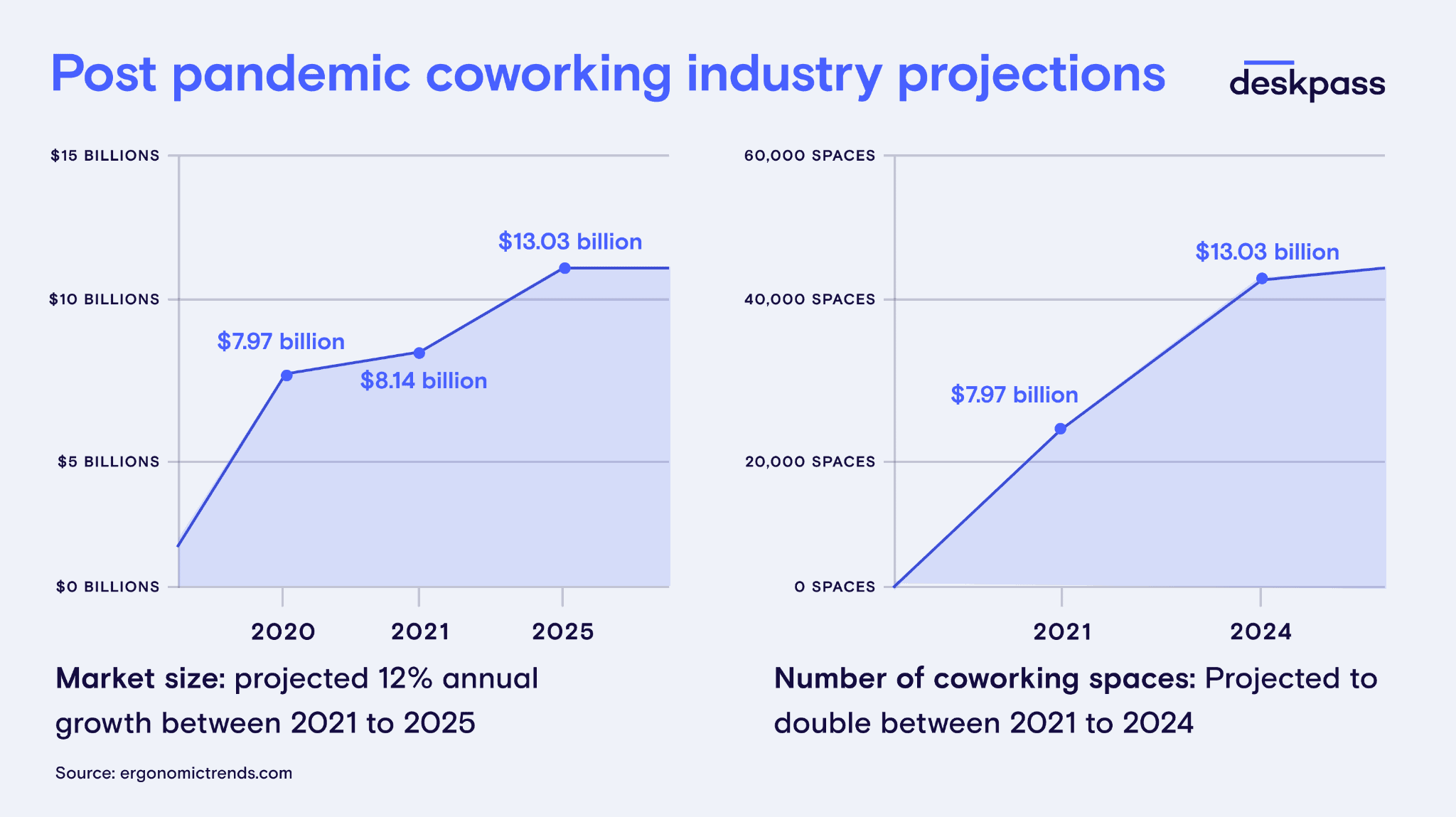
- Since the start of the pandemic, a monumental 8.2 million new individuals have entered the Freelance workforce in the United States alone, fundamentally altering the composition of the independent labor pool.
- A significant 96% of these recent entrants expressed an intention to continue and expand their independent careers in the long term, cementing this shift.
- The corporate adoption of remote work, a critical enabler of the Freelance model, is projected to stabilize with permanent remote employment accounting for an average of 34.4% of company workforces.
- This is more than double the pre-pandemic average of just 16.4%, indicating a permanent structural change in business operations and talent strategy.
- India’s contribution to the global gig economy is set to become a dominant force, with forecasts predicting a total of 350 million gig workers in the country by the year 2025.
- This massive workforce is expected to fuel a national gig economy that will soar to an estimated value of $455 billion by 2024, growing at a rapid CAGR of 17%.
- The physical manifestation of the independent work trend is the coworking space, which is predominantly utilized by the Freelance community across the globe.
- Globally, 42% of individuals working in coworking spaces are freelancers, confirming these shared spaces as the new, professional meeting grounds for the self-employed.
- The market for shared, flexible workspaces is expanding rapidly to accommodate the growing number of independent professionals, with a total of nearly 20,000 coworking spaces available worldwide.
- It is projected that a total of 3.94 million people globally will be using coworking facilities by the end of 2025, demonstrating the professionalization of the independent workspace.
- Despite the rise of coworking spaces, the overwhelming majority of Freelance professionals still operate primarily from their residences, with a strong 82% of independent contractors reporting that they work entirely from home.
| New US Freelancers Since the Pandemic | 8.2 Million |
| Projected Permanent Remote Work % of Workforce | 34.4% |
| Projected Gig Workers in India (2025) | 350 Million |
| Percentage of Coworking Users Who are Freelance | 42% |
| Total Projected Coworking Users (2025) | 3.94 Million |
| Freelancers Working Exclusively from Home | 82% |
Conclusion
Overall, the Freelance model has moved past being a temporary trend and is now solidifying its position as a new, high-growth, and permanent fixture of the global economic infrastructure. From the $1.5 trillion valuation of the global market to the projected 90.1 million freelancers in the United States by 2028, the numbers confirm a big shift.
The highly educated, skilled professional is increasingly choosing freelancing, using their expertise in AI, programming, and finance to bid premium rates that often eclipse traditional salary brackets. As businesses continue to prioritize agility and access to specialized global talent, the Freelance economy will continue its aggressive expansion, making it a critical area of focus for economic analysts and business leaders alike. I hope you like this article. Thank you for staying up until the end.
FAQ.
The global freelance workforce is massive, with estimates suggesting there are over 1.57 billion freelancers worldwide, which accounts for nearly half of the global working population.
In the United States alone, there are over 76 million freelancers (as of 2024), representing approximately 38% of the U.S. workforce. This group contributes an estimated $1.5 trillion annually to the U.S. economy.
Yes, the growth is projected to continue rapidly. By 2027, it’s estimated that the majority of the U.S. workforce (around 51%) will be participating in freelance work in some capacity.
Globally, the average hourly rate for a freelancer is around $21. However, this rate is much higher in countries like the U.S., where the average is closer to $47.71 per hour for all freelancers.
A significant majority of full-time freelancers, often over 60%, report that they earn more than they did at their previous traditional employment.
Highly sought-after freelance skills often involve tech and specialized knowledge. Key areas include Web/Mobile Development, Graphic Design, Digital Marketing (e.g., SEO and social media), IT, and specialized Business Consulting.
The primary motivations for choosing a freelance career are flexibility (control over one’s schedule and hours), the desire to be one’s own boss, and having greater control over one’s financial future and potential income.
Freelancers generally report high job satisfaction. Over 75% of full-time freelancers express satisfaction with their career choice.
A common hurdle for freelancers is the consistent acquisition of work, often referred to as finding projects or clients. Another major concern is the lack of traditional employee benefits, such as employer-sponsored retirement plans and health insurance.

Jeeva Shanmugam is passionate about turning raw numbers into real stories. With a knack for breaking down complex stats into simple, engaging insights, he helps readers see the world through the lens of data—without ever feeling overwhelmed. From trends that shape industries to everyday patterns we overlook, Jeeva’s writing bridges the gap between data and people. His mission? To prove that statistics aren’t just about numbers, they’re about understanding life a little better, one data point at a time.



